The new route of the Mont Blanc Cable Car on the Italian side of Mont Blanc is divided into two sections:
La Palud (1,370m) to Le Pavillon (2,173m)
Le Pavillon Point Helbronner (3,462m)
A total distance of about 4km.
New Mont Blanc Cable Car
The entire route from Courmayeur to Point Helbronner is a new design. The construction started in 2011, with completion in the spring of 2015 and a total investment of 110 million Euros.
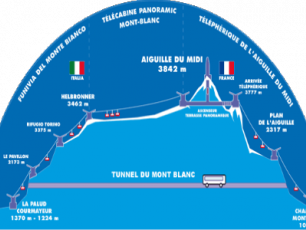
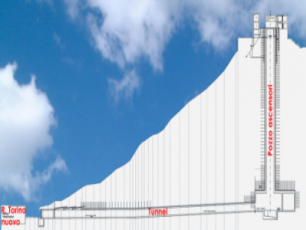
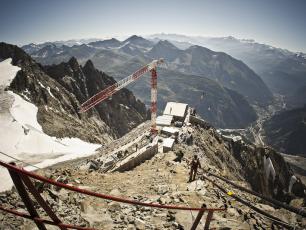
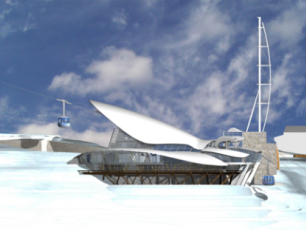
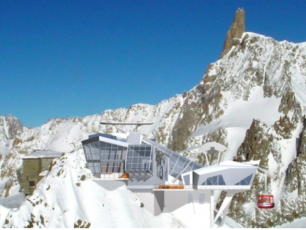
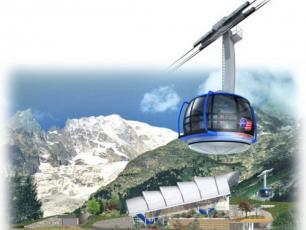

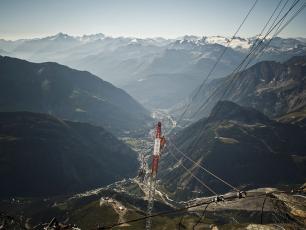
The bottom station is moved from La Palud (1,370m) to Entrèves (1,300m), just below the entrance of the Mont Blanc Tunnel (italian side) and at the end of the autostrada A5, so access will be excellent.
The mid station is still at Le Pavillon, but with a completely new station being constructed.
From Le Pavillon, the higher section rises all the way to Point Helbronner, by-passing the Torino Hut.
The Torino Hut station no longer exists as a lift station, but still operates as a mountain refuge connected to Point Helbronner through the rock of the mountain, with a 154m horizontal tunnel and a vertical lift of 70m.
The travel time on the lower section of the route, Entrevers to Le Pavilon, is about 4 minutes.
The travel time on the higher section of the route, Le Pavillon to Point Helbronner is about 6 minutes.
The Cabins of the Telepheriques are completely new: larger and spherical, with a capacity of 80 people, instead of the previous 20. Each cabin will rotate through 360 degrees during travel. Large glass windows all the way around and a heating system to prevent condensation are part of the modern design. The cabins have LED lighting and multimedia equipment (TV and Audio) to deliver information. The new cable car system is constructed by Doppelmayr.
The new lift system will eliminate the long queues, improve comfort and make the route to view Europe's highest peak quicker, more comfortable and more informative.
Three New Stations
All three stations have wonderful architectural designs and have been fabricated with steel, wood and glass, from the rock up.
Pontal d'Entréves
Pontal d'Entréves is the base station, built on 2 levels with a total area of 3,900m². It is a ribbed stainless steel structure with wood frames and an abundance of glass to optimize the use of natural light. The roof is a hightech and futuristic design. There are dedicated areas for personnel, administrative offices, locker rooms and extensive storage space.
Outside, a large green (in summer) area surrounds the station.
Communication links are optimized with underground parking (336 spaces) a bus terminus for local public transport, from the centre of Courmayeur, and extensive coach parking for vehicles from all across Europe.
Le Pavillon du Mont Fréty
The Pavillon du Mont Fréty is the mid station: three structures on two floors, with a total area of 2,200m².
The highest of the three structures is 15m tall, with large windows allowing great views of Val Veny and Val Ferret.
Inside Le Pavillon station there is a shopping area, plus restaurants and bars.
From the reception area, elevators take visitors to the two higher levels of the station. From the reception, there is access to terraces on both sides of the structure and a pathway to the current Pavillion hut.
The old station is now a museum area.
Point Helbronner
The Point Helbronner station has four levels with a total area of 2,250m². The available base area is limited, so the station is tall and thin with cantilevered terraces. The structure has been developed using high performance materials of titanium panelling, zinc plated steel and exceptionally tempered glass providing resistance to the extreme environment with particualr attention to the prevention of snow and ice collection on external surfaces.
On the top level, there is a 14m diameter circular terrace, providing an amazing 360 degree panorama with great views of Mont Blanc, the Dent du Géant, Les Grandes Jorasses and the Vallée Blanche.
One level down, on the west side, a large dome creates an internal space with an expansive view and a self-service restaurant. On the east side, there is a terrace with a cafè.
Torino Hut Tunnel
The elevator that connects the Torino Hut to Point Helbronner has a 1000kg load capacity and can carry 13 passengers. The tunnel, from the foot of the elevator to the Hut, not only serves as a connection between the Point Helbronner station and the Torino Hut, but also as a place to house electrical, heating and water systems in their own special compartments.
High Altitude Construction
Work at the mid and top stations is particularly difficult because of the altitude. The pressure of oxygen is considerably less than is commonly experienced by most construction workers. The weather can be adverse, with very low temperatures and high wind speeds. The top station is an extremely hazardous work environment.
To mitigate against the environment, exterior work was performed during the summer months. During the winter months, work was focused predominantly on the tunnel and lift shaft connecting the Point Helbronner Station to the Torino Hut.
The Architects are Carlo Cillara Rossi and Guido Incarbone
Carlo Cillara Rossi has designed many mountain infrastructure projects in mountainous areas delivering lift systems and tourist facilities to ski resorts. These projects have been carried out with high awareness of the environmental impact, the application of renewable energy sources and energy saving technologies.
The intention is to construct to the "Zero Energy Building" standard; self-sufficient buildings that do not require external energy. To achieve this objective, insulation is extensive, large photovoltaic surfaces convert energy and heat recovery systems reuse energy.
The new Lift Systems and Stations are an architectural and engineering phenomenon that will amaze visitors through the use of technology, without losing focus on the Mont Blanc landscape.


 4.9 nodi km/h SW
4.9 nodi km/h SW